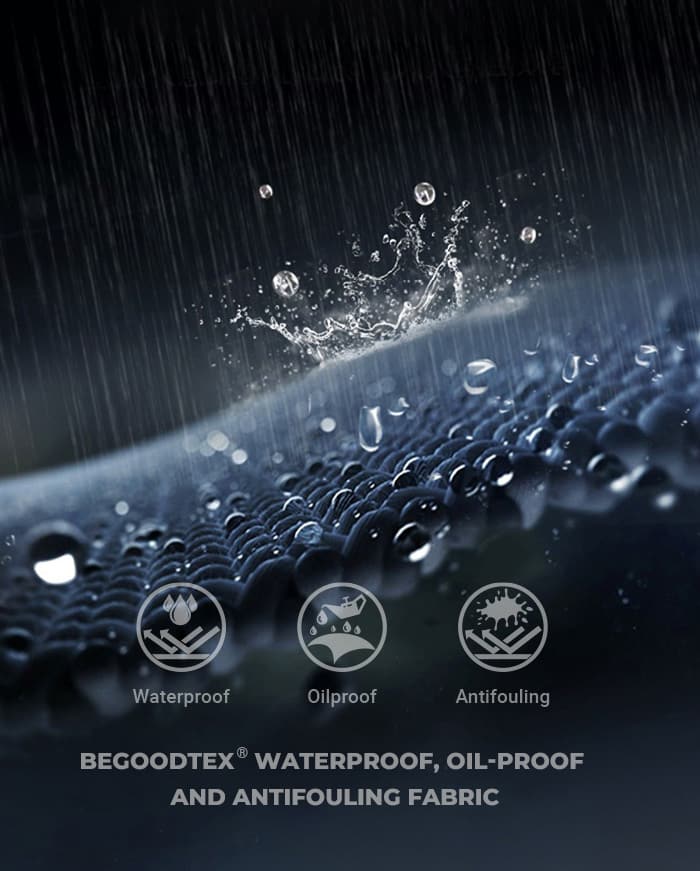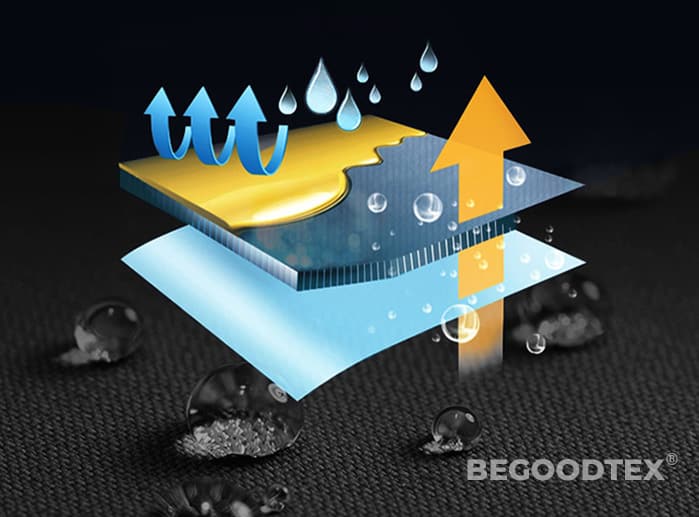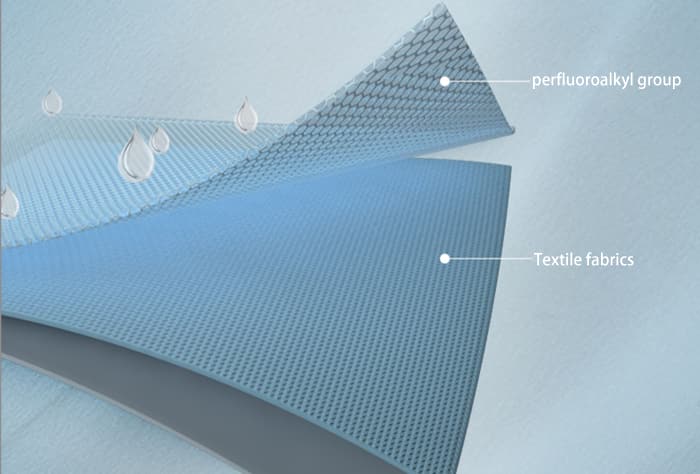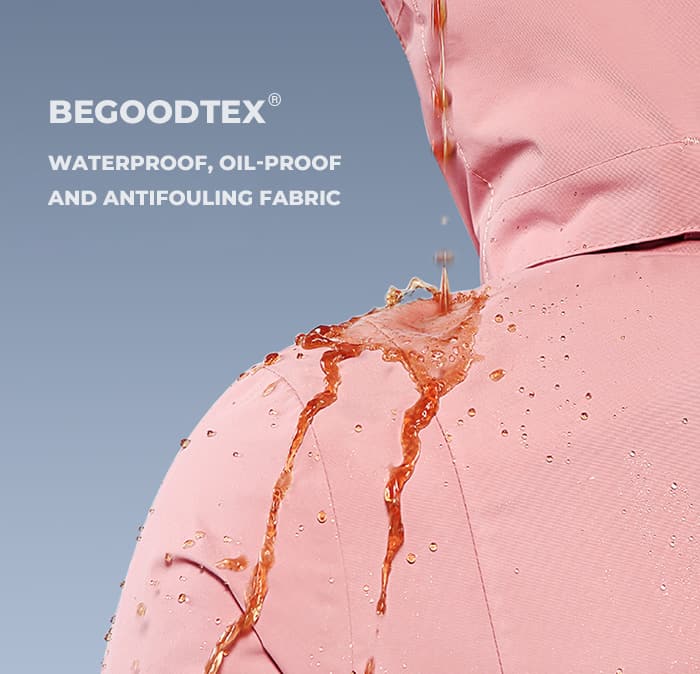Can’t Find What You Are Looking For? Find Out About Our Bespoke Design Solutions. Read More.
IFR + Waterproof Fabric
Anti-UV fabric is a type of textile that is designed to block ultraviolet radiation.
It is commonly used in clothing, outdoor furniture, and shade structures to protect people and objects from the harmful effects of UV radiation.

What Is Flame retardant Waterproof Fabric?
The term “three-proof” fabric refers to fabric that has been treated with technology to form a stable air interface protective film on its surface. This film helps prevent water, oil, and stains from penetrating the fabric. The fabric treated with such a process is called a “three-proof” fabric.
The true waterproof and oil-proof fabric refers to the fabric that can resist oil without soaking it and can resist water without seeping.
It is suitable for making protective workwear that frequently comes into contact with oil and water, and is widely used in industries such as petroleum, chemical, gas stations, mining, chef uniforms, repair, and others.
Waterproof: The fabric is coated with a water-resistant film that prevents water penetration without closing the fabric’s pores, making it both water-resistant and breathable.
Oil-proof: When the fabric does not absorb oil, it exhibits oil resistance.
Anti-stain treatment involves reducing the speed and degree of soiling, making it easier to clean. This includes finishes that are both easy to clean and resistant to dirt.
Easy-to-clean fabric refers to fabric that is simple to wash or wipe clean after being stained by pollutants. The fabric treated with an easy-to-clean agent has dual functions: anti-stain and easy-to-clean. In other words, it is resistant to oil stains during use. Once stained, it can be easily washed under normal conditions.
If the fabric has oil and water resistance as well as anti-stain properties simultaneously, it can be referred to as a “three-proof” fabric.
Water Repellent Finishing Mechanism
The water repellency of the fabric refers to its ability to repel water droplets from its surface. The purpose of water repellent finishing is to prevent water from wetting the fabric and to stop liquid water from penetrating it, while still maintaining the fabric’s breathability and moisture permeability.
After water-repellent finishing, a substance is adsorbed onto the surface of the fabric, causing its original high-energy surface to transition into a low-energy surface. The surface tension changes, causing the fabric changes from hydrophilic to hydrophobic. Water droplets can roll off it without wetting it. The smaller the surface area, the better the effect.
In terms of the moisture permeability of the fabric after waterproof finishing, it can be divided into moisture-permeable waterproof finishing and non-moisture-permeable waterproof finishing.
• Moisture-permeable waterproof finishing: Hydrophobic substances form a continuous film on the fabric surface, which can prevent water penetration and withstanding prolonged rain and specific water pressure. Clothing usually adopts moisture-permeable waterproof finishing, providing a certain level of waterproof performance without compromising the fabric’s breathability. This ensures comfort while wearing the clothing, preventing a stuffy and hot sensation.
•Non-moisture permeable waterproof finishing: Non-moisture permeable waterproof fabrics are usually used for waterproof canvas, tents, and packaging.


Oil Repellent Finishing Mechanism:
Perfluoroalkyl groups should be chosen as the oil-repellent groups. After the oil-repellent agent is applied to the fabric, a new surface with low surface energy is formed, making it difficult for oil to wet it.
The distribution state of the fluorine-containing oil-repellent group on the fiber surface is an important factor affecting the oil repellency. To achieve maximum oil repellency, the necessary amount of oil repellent agent depends on the fabric’s structure and the composition of the fluorine-containing oil repellent agent.
Under the same number of carbon atoms, perfluoroalkane is more effective than substituted branched alkane.
Mechanism of Anti-Stain and Easy-to-Clean Finishing
1. Mechanisms for Anti-staining and Easy-to-Clean Finishing
Anti-staining finishing includes preventing oil stains (not easy to adhere to oil stains), easy removal of stains after contamination (easy-to-clean), and preventing recontamination during washing (anti-re-staining). To achieve the goal of anti-staining, it is necessary to carry out anti-oil-staining finishing and easy-to-clean finishing.
There are generally three methods to impart anti-staining properties to fabrics: sizing method, film-forming method, and fiber chemical modification method.
The sizing method forms a protective layer of sizing material on the surface of the fabric. This protective layer loosens partially or completely during washing, which promotes the removal of adsorbed dirt and facilitates easy cleaning. This anti-staining effect is not durable and belongs to temporary anti-staining finishing.
The film-forming method utilizes polymer compounds to form a wash-resistant, hydrophilic film on the fiber’s surface. This film enhances the fiber’s wettability during washing and helps to remove attached dirt.
The fiber chemical modification method enhances the anti-staining properties of cotton and synthetic fibers through chemical alteration.
2. Mechanisms for Easy-to-Clean Finishing
Hydrophilic anti-staining finishing, also known as easy-to-clean finishing or degreasing finishing, reduces the critical surface tension of the fiber surface. This makes dirt on the fabric easy to remove and improves resistance to recontamination during washing.
The mechanism of easy-to-clean finishing is related to the diffusion of water and detergent toward the oil-fiber interface.
Easy-to-clean finishing agents can promote the diffusion of water into the interior of the fabric and fiber bundles, as well as the oil-fiber interface.
When the interface and fiber surface are hydrated, the oil stains and fibers can be separated.
When the fiber surface is coated with easy-to-clean finishing agents, water can diffuse through the finishing agent, making it easier to remove dirt and leading to the separation of oily stains.
Advantages of BEGOODTEX Waterproof Fabrics
- Lower tendency to yellowing, suitable for light and white fabrics.
- Prevents stains from settling in the amorphous area of fibers, making it easy to remove stains from the fabric.
- Significant anti-dry stain performance, dust and dirt can be easily removed by brushing, allowing clothing to maintain a fresh appearance for an extended period.
- Good operability, does not soil the drum, maintaining production efficiency.
- Excellent water washing resistance ensures that the fabric can still maintain excellent protection after multiple washes.
- The product does not contain volatile organic solvents or flash, and there are no volatile substances released during drying and baking.
- Does not affect the breathability of the fabric, comfortable to wear.
Applications of Waterproof Fabrics
- A. Field Army Uniforms, Firefighting, and Military Special Clothing
- B. Protective equipment, Military tents, Sleeping bags, and Postal bags
- C. Sportswear for mountain climbing, skiing, golf, etc.
- D. Materials for shoes, hats, luggage, light-blocking curtains, and UV-resistant umbrella fabric.
- E. Waterproof and breathable raincoats, ideal for leisure activities and wind protection.
- F. Medical Insurance Supplies

